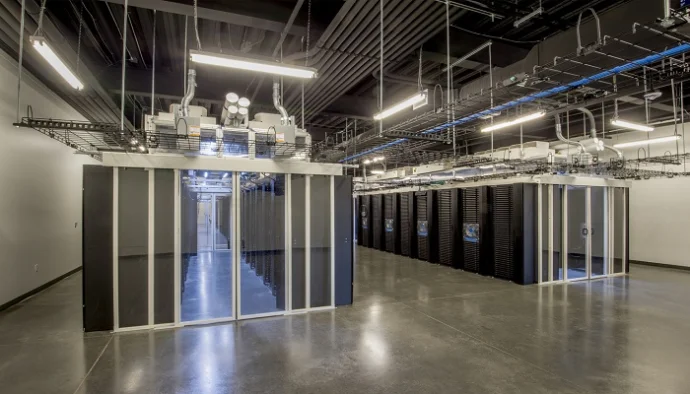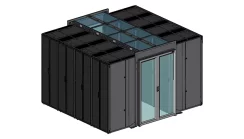The Energy Efficiency Benefits of Cold and Hot Aisle Containment
As datacentres look to increase their energy efficiency and provide predictable cooling to their high-density racks, they are faced the choice of whether to adopt hot-aisle or cold-aisle containment. Aisle containment can offer benefits to both existing and new build datacentres and can help to remove ‘hot-spots’ and deliver uniform air temperatures to server inlets.
What is Datacentre Aisle Containment?
In an uncontained air flow data centre, room cooling systems are tasked with the delivery of cool air throughout the room. This is an uncontained layout and can lead to less predictable air flow within the room and potentially the need for computational fluid dynamic (CFD) modelling.
More info: https://en.wikipedia.org/wiki/Computational_fluid_dynamics
In a server room or datacentre environment racks can be arranged into hot and cold-aisles. The front of the racks draw-in cool air (cold-aisle) and exhaust this through the rear of the cabinets into a ‘hot-aisle’. Containment looks to separate the cool and hot air and avoid them mixing and leads to drier and warmer air being returned to the air conditioners for cooling. Analysis shows that hot-aisle containment can lead to higher energy savings (up to 40%) and is the preferred option for new-build datacentres. The benefits of either containment approach can be summarised as:
- Energy Savings: containment will lead to energy savings within a datacentre or server room environment from around 9-40% over an uncontained facility.
- Higher Cooling System Temperatures: can be set to a higher supply level which will save energy and increase available cooling system capacity. This in turn can raise the return temperature and lead to more efficient heat exchange with the air conditioner cooling coils.
- Hot-Spot Elimination: the use of containment prevents the hot and cold air mixing. This means that the temperature of the air reaching IT inlets is uniform and the same as that leaving the air conditioner. If there is no mixing, supply air temperatures can be raised without the risk of rack hot-spots and whilst gaining compressor hours.
- Increased Compressor Hours: with a lower outdoor temperature than in the server room or datacentre, the outdoor air conditioning compressors do not have to work (as hard) to reject heat. As the compressors are run less or turned-off, energy is saved.
- Reduced Humidification/De-humidification Costs: with an increased cooling system supply air temperature, the cooling system can operate above the dew point temperature. This means that there is no need to remove humidity from the air, saving energy and water.
- Right-sizing Cooling Systems: being able to deliver predictable cooling using containment removes the need for oversizing the cooling system in terms of fan numbers and sizes.
Cold Aisle Containment Systems (CACS)
A cold-aisle containment system encloses the cold aisle only. The rest of the datacentre becomes a hot-air return plenum. This allows the temperature outside the cold aisle i.e. the rest of the datacentre to increase. The hot and cold air flows are separated, and care must be taken to make sure that both temperatures are monitored to avoid excessive heat being presented to sensitive equipment. The cold-aisle containment method requires the rack rows to be arranged into a consistent hot-aisle and cold-aisle configuration.Hot Aisle Containment System (HACS)
A hot-aisle containment system encloses the hot aisle only and collects the heat output from the IT equipment. The rest of the datacentre becomes a cold-air return plenum. The two air supplies are prevented from mixing. Again this arrangement requires the datacentre racks to be arranged into a consistent hot-aisle and cold-aisle configuration. This type of HAC is ideal for new build datacentres, smaller datacentres and server rooms and high-density rack zones.
An alternative HACs arrangement is to have the air ducted from the hot-aisle containment to a computer room air handler (CRAH) or large remote AC unit using a chimney located above the hot-aisle containment. This arrangement is best suited to new datacentres and may require bespoke fabricated air plenums and a custom build to handle the large air flow.
Working Environments and Ambient Temperatures
It is important to ensure that the overall ambient temperatures do not rise uncomfortably high for IT technicians and datacentre engineers. Using a cold-aisle containment system, the general working area becomes the hot-aisle and the reverse is true when using a hot-aisle containment system.
ASHRAE Standard TC9.9 (2008) recommends IT inlet temperatures of 18-27˚C. Using a cold-aisle containment system the air outside the CAC can rise above 27˚C and as high as 38˚C if high density servers are deployed. This can present uncomfortable working and visitor conditions for those not experienced with cold-aisle environments and working practices. Non-racked IT systems may also require their own cooling arrangements (via ducting) in order to ensure their reliable operation in such an environment.
Energy Efficiency Savings
The overall energy efficiency savings of hot-aisle containment over an uncontained environment can be as high as 40% or more. The savings come from less energy required by the cooling system. Cold-aisle containment can also show energy savings over uncontained environments of around 10% in comparison. The difference lies in the way both impact the air return to the cooling system units. Both forms of containment (CACS and HACS) will lose energy efficiency due to cold air leakage. Some air leakage is inevitable, and the ‘waisted’ energy comes from the energy required to power fans and pumps.
Summary
Cold-aisle containment is easier to implement as it does not require additional fabrication to contain exhaust air. A CAC system only requires doors at both ends of the air and a roof partition. Cold-aisles are therefore easier and less costly to install within existing server rooms and datacentres. Cold air can leak through floor tiles and the overall Delta T is lower leading to decreased efficiency.
Hot-aisle containment ensures that the open server room area is colder and provides a more acceptable working environment for technicians and engineers. There should be little impact from leakage from the hot-aisle into the cold space but any represents the potential to lower the overall effect and energy efficiency savings. A HAC system is more expensive and can require bespoke fabrication. The hot-aisle can also be an uncomfortable working area for engineers and technicians who may have to let in cool air during their time in the aisle.
For both sets of server room or datacentre containment system it is important to ensure there is adequate environment and temperature monitoring and to ensure that there are no obstructions for the installed fire suppression system.


























